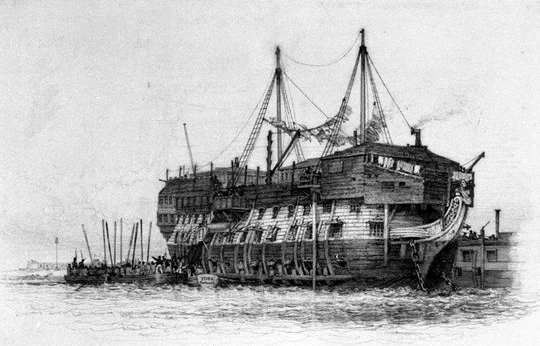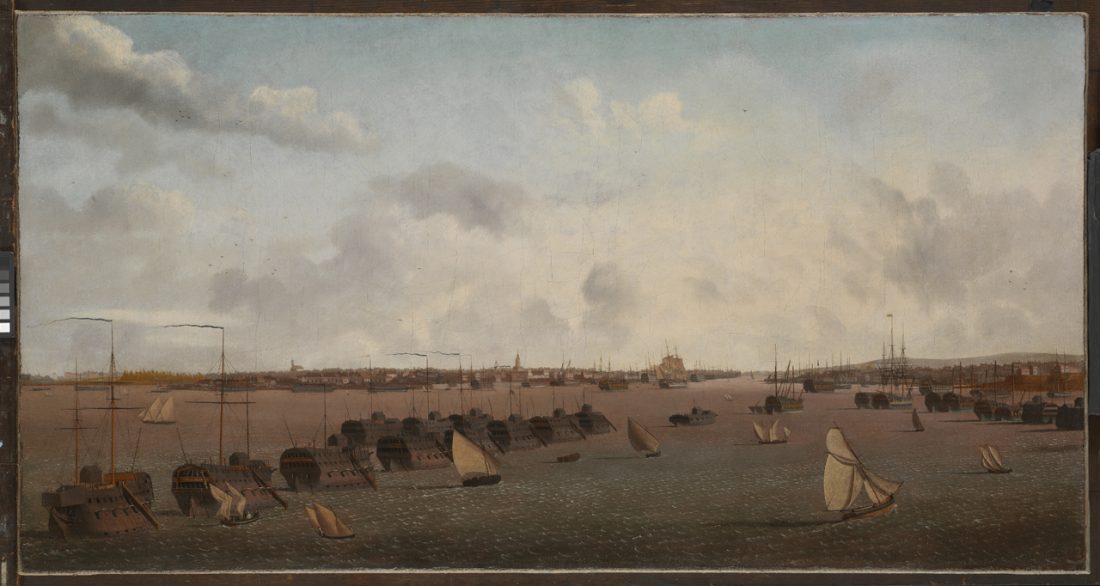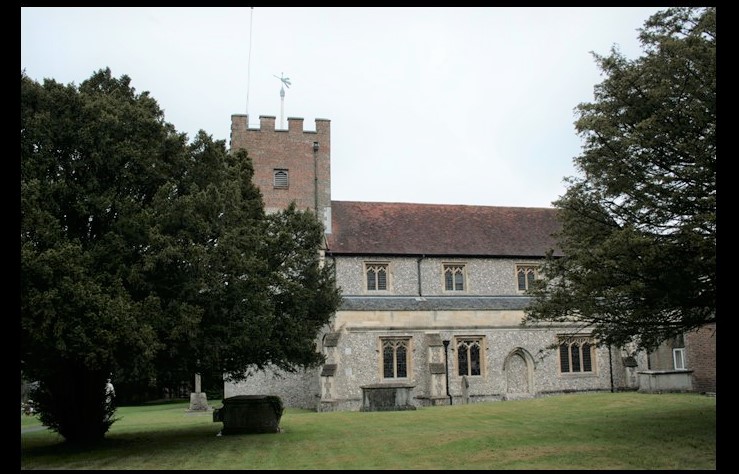Lonely Lives and Deaths
French Prisoners of War in Britain 1793 – 1815
Part 1
Though the focus of my own writing – in my novels of the Dawlish Chronicles series – is on the mid-Victorian period, I retain a lively interest in the Napoleonic era. I have always found the plight of prisoners of war of this time as particularly poignant. Over 100,000 of them were brought to Britain during the wars with France that raged from 1793 to 1815, with only a one-year break in 1802/03. Enlisted soldiers and seamen had the worst of it, many being confined in horrific conditions on moored prison hulks – usually naval vessels that had reached the end of their useful lives as fighting units. Not only prisoners of war were kept on such ships – they were employed for British convicts also and would remain in use up to the 1850s (a major theme in Dickens’ Great Expectations)

HMS York as prison hulk at Portsmouth by William E. Cooke (1811 – 1880)

Prison Hulks at Portsmouth by Ambroise Louis Garneray (1783 – 1857), a French privateer and painter who was a prisoner for eight years
The luckier captives were housed in the specially built prison on Dartmoor, to which many American prisoners were also sent from 1812 to 1815. Officers were however given the opportunity to give their parole – their word of honour, in writing, not to escape – and to live relatively normal lives in lodgings in a few specified British towns. The French established a similar regime for British officer prisoners at Verdun in Eastern France. Unlike earlier wars between Britain and France only limited exchanges of prisoners took place in the Napoleonic period and those unfortunate enough to be captured early in the wars faced long periods in detention. In the case of seamen, removal of skilled men from active service was of particular benefit to the captor. This reflected the fact that, given the technology of the time, an effective soldier could be trained in a matter of weeks whereas mastery of nautical skills demanded years of experience.

Church of St. John the Baptist, Alresford – a small town in Hampshire that became a detention centre for French officers
For French and British officer prisoners – and for the large number of wealthy British civilian tourists whom the French somewhat unsportingly interned in 1803 – life was as close to normal as was possible in the circumstances. Social relations seem to have been relaxed – and even warm, as will be discussed in the second part of this article. Once the initial fervour of Revolution had died down and social stability had been restored by Napoleon, ideological differences as we understand them today were almost non-existent. The concept of “a gentleman” transcended national boundaries and, apart from the painful necessity of fighting each other occasionally, personal animosity seems to have been remarkably low between the British and the French at all levels of society. This may have been due to the facts that Britain’s civilian population was never exposed to French foraging and that when Britain did invade France, in 1814, Wellington ensured that French civilians were spared the sort of rapine that had disgraced British victories in Spain at Badajoz and San Sebastian.

Lucien Bonaparte
The most notable French prisoner in Britain was Napoleon’s brother, Lucien, who had fallen out with the Emperor in 1809 and who attempted to flee from Italy to the United States. He was captured by the Royal Navy and brought to Britain – where on landing he was apparently cheered by a crowd that approved his part in the family quarrel. Placed under liberally-interpreted “house arrest”, Lucien was permitted by the British Government to purchase a large country house at Thorngrove in Worcestershire and to establish himself as a member of local society. His son, also Lucien and later a distinguished philologist, was born there and two of his daughters would later marry into the British aristocracy.
Large numbers of less highly connected officers also spent long periods in Britain. On arrival in Britain an officer prisoner was the responsibility of the Admiralty’s Transport Board. Once he had signed a parole document he was provided with a copy of its terms in French and English. It also carried a physical description of him, so that it served as an identity card which he was thereafter required to carry. Formalities complete, the prisoner was assigned to a “parole town”. One such was the Alresford, one of no less than eleven such towns in Hampshire and one which still contains sad memorials to these men in the graveyard of its church.

French prisoners’ gravestones, church of St. John the Baptist
The Transport Board had an agent in each town – in Alresford’s case a solicitor called John Dunn – who arranged for billeting the prisoner on a suitable local family. Each prisoner was required to report to the agent twice a week, an obligation made less onerous by being also the occasion for drawing one shilling and sixpence a day for subsistence. The agent heard and resolved complaints, supervised conduct, and submitted reports and accounts to the Transport Board, which hoped to recover costs from the French Government at the end of hostilities. Should a prisoner die, then the agent arranged the funeral, sold his possessions, and as far as circumstances allowed transmitted the proceeds to his family. Some prisoners had their wives living with them, possibly captured at sea and choosing to stay with their spouses in captivity.

Jane Austen
In Alresford prisoners were free to walk up to one mile along the turnpike road – now the A31 highway – which led eastwards towards Guildford, 30 miles away, and westwards to Winchester, 8 miles distant. The prisoners were not permitted to leave the highway or cross fields and it is not clear if they were allowed to walk on lesser roads leading from the town. Any such prohibition would have been very painful since Alresford is set in one of the most beautiful rural landscapes in Britain and strolling in it would have been some solace to the prisoner. The village of Chawton, home of the novelist Jane Austen (1775-1817), lies a mere 9 miles to the east and she would have used the turnpike on her frequent visits to Winchester (where she later died). As she passed through Alresford, Jane would almost certainly have seen French officer-prisoners. She would perhaps have felt a chill at the realisation that her two brothers in the Royal Navy might someday endure a similar fate in France. Though she makes a naval officer the hero of “Persuasion”, and as her cousin Eliza’s French husband had been guillotined during the Terror, it is regrettable that she did not work in a French prisoner as a character.
The Transport Board’s daily allowance seems to have been on the meagre side and many of the prisoners supplemented their incomes by giving lessons in French, fencing or drawing. Others seem to have made for sale tobacco boxes, sets of dominoes and bobbins used in making lace. Some may have built model ships of the type made from bone and rigged with human hair which are associated with French prisoners – one occasionally appears at auction houses. Whether to supplement their diet, or to satisfy French gastronomic taste, prisoners were frequently seen gathering snails, much to the amazement of the locals.
In Part 2 of this article, due next week, we’ll learn something about the personal stories of some of the prisoners buried in Alresford.
In preparing the above article I have been heavily indebted to the “About Alresford” website and to an article on it by Peter Hoggarth, dating from 1991, on the French prisoners. The photographs have been taken by myself.



